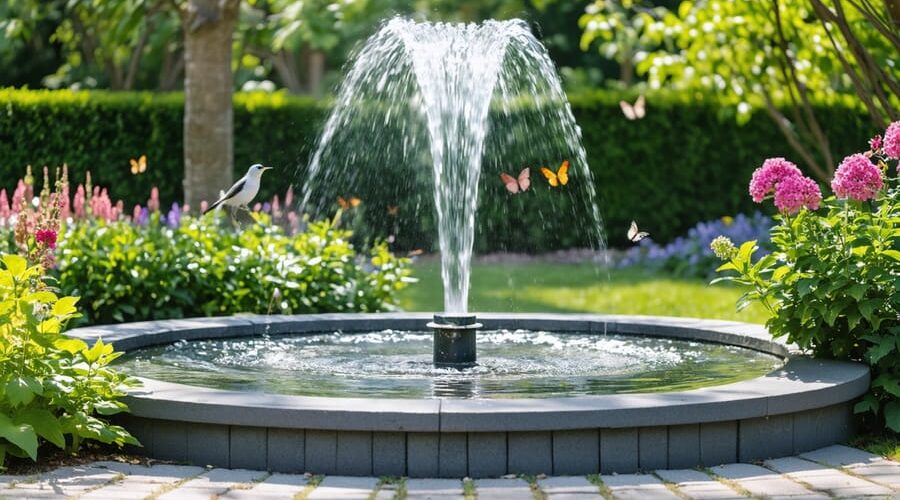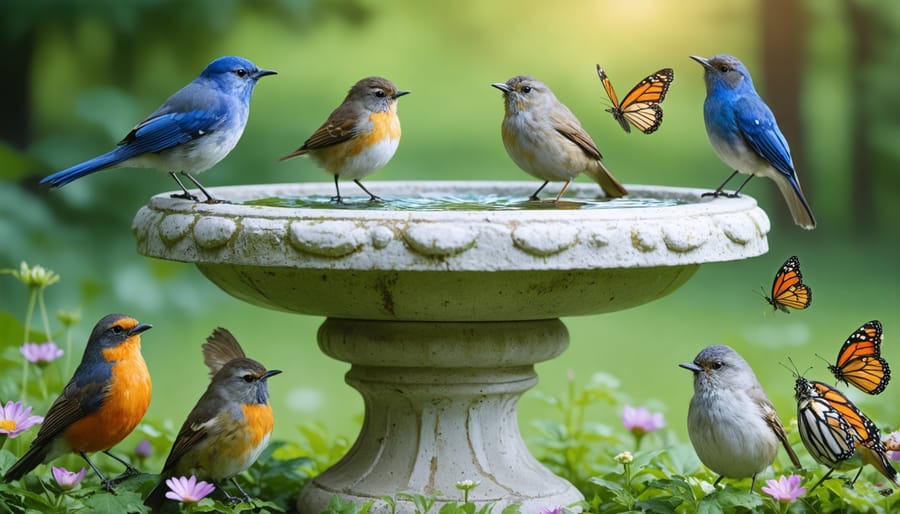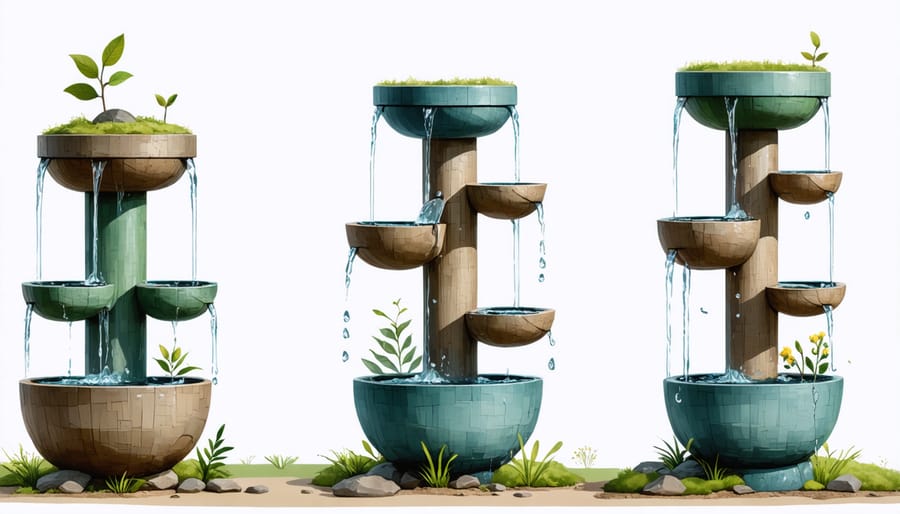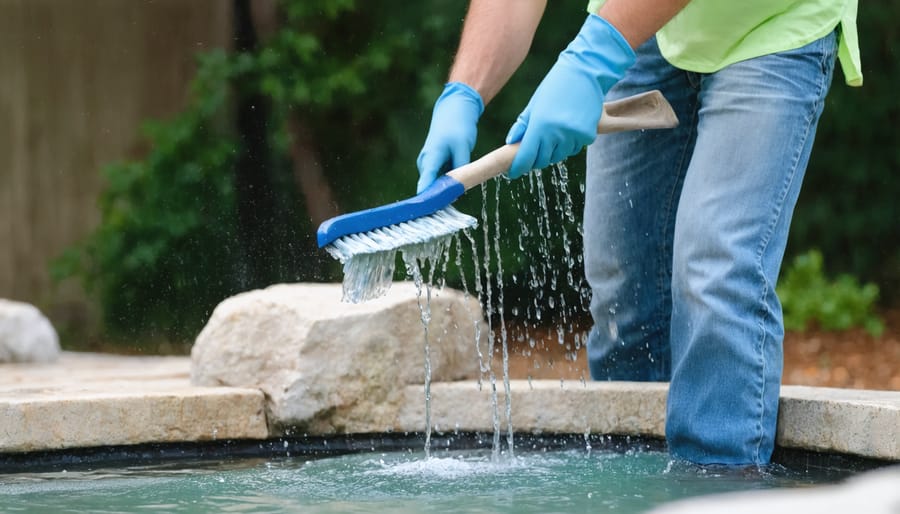
Transform Your Garden Into a Wildlife Haven With This Simple Water Feature
Transform your backyard into a vibrant wildlife sanctuary with a thoughtfully designed water fountain that serves both as a stunning focal point and a vital resource for local fauna. From chirping songbirds taking their morning baths to butterflies gathering for a refreshing drink, a wildlife water fountain creates an enchanting ecosystem right outside your window. Beyond its aesthetic appeal, this sustainable feature plays a crucial role in supporting biodiversity, especially during dry spells when natural water sources become scarce. Whether you’re a seasoned gardener or just beginning your outdoor journey, installing a wildlife water fountain offers an accessible way to connect with nature while enhancing your outdoor space with the soothing sounds of flowing water. As urban development continues to impact natural habitats, these artificial water sources become increasingly important sanctuaries for our wild neighbors, providing essential hydration and creating a dynamic hub of activity that brings your garden to life.
Why Wildlife Need Water Features
Local Species That Will Visit
A wildlife water fountain will quickly become a bustling hub for local creatures seeking refreshment. Birds are often the first visitors, with species like robins, finches, and chickadees stopping by for drinks and baths. Butterflies and bees will gather at shallow areas, while dragonflies might patrol the water’s edge. Small mammals such as squirrels, chipmunks, and rabbits frequently visit for a drink, especially during dry spells. You may even attract beneficial garden allies like toads and lizards, which help control pest populations. Morning and evening hours typically see the most activity, so position your fountain where you can enjoy watching these delightful visitors throughout the day. Remember that different species prefer different water depths, so incorporating varying levels in your fountain design will attract the widest variety of wildlife.

Environmental Benefits
Wildlife water fountains play a crucial role in supporting local ecosystems and biodiversity. By providing a reliable water source, these fountains become essential habitats for various species, from birds and butterflies to beneficial insects and small mammals. During dry spells and urban development, these water features become lifelines for wildlife that might otherwise struggle to find natural water sources.
The moving water helps prevent mosquito breeding while creating a healthier environment for beneficial insects that help pollinate gardens. Birds visiting the fountain not only add life to your garden but also assist with natural pest control. By attracting diverse wildlife, these fountains help maintain the delicate balance of local ecosystems and create stepping stones between fragmented habitats in urban areas.
Moreover, wildlife fountains can help conserve water compared to traditional birdbaths, as the recirculating system minimizes water waste while maximizing benefits for local wildlife.
Building Your Wildlife Water Fountain
Materials and Tools Needed
To create your wildlife-friendly water fountain, you’ll need the following materials and tools. For the fountain base and structure:
– Large ceramic or concrete basin (18-24 inches diameter)
– Solar-powered water pump (150-200 GPH)
– Natural stones or rocks (various sizes)
– Flexible water tubing (½ inch diameter)
– Wire mesh or grating
– Waterproof sealant
For wildlife accessibility and safety:
– Shallow pebbles or river rocks
– Small branches or driftwood
– Plant materials for surrounding area
– Level tool
– Garden spade
– Safety gloves
– Clean rags
Optional decorative elements to enhance your DIY water features:
– Native aquatic plants
– Decorative pebbles
– Solar-powered lights
– Natural fiber rope
– Garden staples or pins
Maintenance supplies:
– Water testing kit
– Algae prevention tablets
– Small net for debris removal
– Spare pump filter
– Clean bucket for water changes
Most materials can be found at your local garden center or hardware store. Choose weather-resistant materials that will withstand outdoor conditions and seasonal changes.

Construction Steps
Before starting construction, gather all materials and tools in a clear workspace. Safety should be your priority – wear protective gloves and eye gear when handling tools and materials.
Begin by selecting a level spot in your garden that’s easily accessible to wildlife but away from dense vegetation. Dig a shallow basin about 4-6 inches deep and 2-3 feet wide, depending on your fountain size. Line the area with landscape fabric to prevent weed growth.
Install your submersible pump following the manufacturer’s guidelines. Similar to creating garden waterfall techniques, ensure the pump is centered and the power cord can reach your outlet without stretching.
Layer the bottom with gravel, creating a stable foundation. Position larger rocks around the edges, forming natural-looking steps that wildlife can use to access the water. Remember to leave gaps between rocks for smaller creatures.
Place your fountain head or spout, connecting it securely to the pump. Test the water flow and adjust as needed. The sound should be gentle – too loud might scare away timid wildlife.
Add smaller stones and pebbles to cover any exposed liner and create a more natural appearance. Consider adding aquatic plants around the edges for additional cover and natural filtering.
Fill the fountain with fresh water and run it for a few hours to ensure everything works properly. Keep the water level about 2-3 inches below the rim to prevent overflow.
Finally, create a gradual slope on at least one side using stones or gravel to help smaller animals safely access the water. Regular maintenance will include checking water levels, cleaning debris, and ensuring the pump functions correctly.
Remember to place your fountain where you can enjoy watching your wild visitors while giving them enough space to feel safe approaching the water.
Wildlife Safety Features
When designing a wildlife water fountain, safety features are crucial for protecting our feathered and furry visitors. Start with gently sloping sides that allow easy access and exit for all creatures, from tiny songbirds to larger mammals. Include multiple water depths, with shallow areas around 1-2 inches deep for smaller animals and deeper sections for larger wildlife.
Install rough-textured surfaces or small stones along the edges to provide secure footing and prevent slipping. This thoughtful addition can enhance your garden’s nighttime appeal while keeping nocturnal visitors safe.
Consider adding partially submerged branches or floating platforms to create safe landing spots for birds and escape routes for smaller creatures. Keep water flow gentle and consistent to prevent splashing that might startle wildlife. A pump filter guard is essential to protect curious animals from injury, while also maintaining water clarity.
Remember to position your fountain away from areas where predators might hide, giving wildlife clear sight lines and multiple escape routes. This creates a stress-free environment where animals feel comfortable visiting your water feature.
Maintaining Your Wildlife Fountain
Regular Maintenance Tasks
Keeping your wildlife water fountain in top condition requires regular attention to ensure it remains a safe and inviting spot for local creatures. Start each morning with a quick visual inspection to remove any fallen leaves, twigs, or debris that might have accumulated overnight. This simple task prevents pump clogs and maintains water quality.
Every few days, check the water level and top it up as needed – animals are surprisingly thirsty! During hot weather, you might need to do this daily. While you’re at it, take a moment to ensure the pump is running smoothly and creating the right amount of water movement.
Weekly maintenance should include a more thorough cleaning of the fountain basin. Use a small net to scoop out settled debris, and gently scrub any algae buildup with a soft brush. If you notice the water becoming cloudy, perform a partial water change, replacing about one-third of the water with fresh.
Don’t forget to check the pump filter weekly and clean it if necessary. In autumn, you’ll need to remove fallen leaves more frequently to prevent them from decomposing in the water.

Seasonal Care Tips
As seasons change, your wildlife water fountain needs different care to keep it running smoothly. In spring, thoroughly clean the basin and check the pump after winter storage. Remove any debris and treat the water with a pet-safe algae preventive to prepare for increased wildlife activity.
During summer, maintain consistent water levels as evaporation increases. Check the fountain daily and top up as needed. Keep surrounding plants trimmed to prevent excess debris from falling into the water. Consider adding floating plants to provide shade and reduce algae growth.
When autumn arrives, install a leaf net to catch falling foliage and prevent pump clogs. Clean the fountain more frequently to remove leaves and prepare for winter. In freezing climates, either install a de-icer to maintain open water for wildlife or drain and store your fountain indoors.
For year-round operation in mild climates, adjust water flow seasonally – stronger in summer for better aeration and gentler in winter to prevent splashing and ice formation. Remember to check pump function monthly and clean filters according to seasonal debris levels.
Creating a wildlife water fountain in your garden is more than just adding a beautiful feature – it’s about making a meaningful contribution to your local ecosystem. By providing a reliable water source, you’re helping birds, butterflies, beneficial insects, and small mammals thrive in your neighborhood. The gentle sound of flowing water creates a peaceful atmosphere while supporting nature’s delicate balance.
Remember, your wildlife water fountain doesn’t need to be elaborate or expensive to be effective. Even a simple design can make a significant impact on local wildlife populations. The key is to maintain it regularly, keep the water clean, and ensure it remains accessible throughout the year.
Why not start your wildlife water fountain project this weekend? With just a few materials and some basic DIY skills, you can transform your outdoor space into a wildlife haven. Not only will you enjoy watching the diverse creatures that visit your fountain, but you’ll also be playing an important role in wildlife conservation right from your backyard.
Take that first step today – your local wildlife will thank you, and you’ll create a lasting connection with nature that brings joy and satisfaction for years to come.
